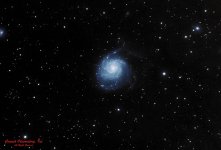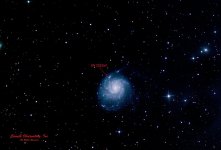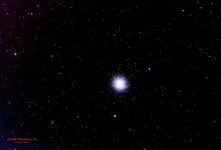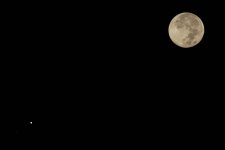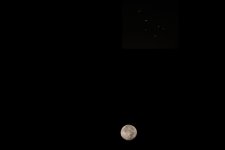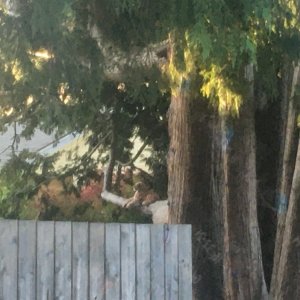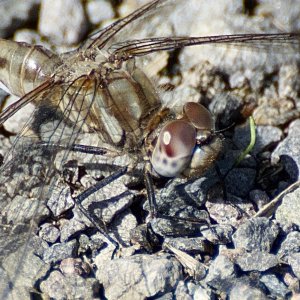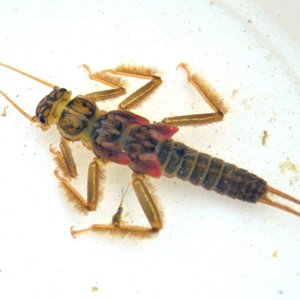A lot in this image, captured a few nights ago, some galaxies in the Virgo Cluster, a group of more than 1300 galaxies.
M 60, the third brightest member of the cluster, is an elliptical galaxy discovered by Johann Gottfried Keohler in April of 1779; Charles Messier added it to his catalogue 4 days later. M 60 is an elliptical galaxy, which unlike spiral galaxies, lack an organized structure and appear rather featureless. M 60 has a diameter of about 120,000 light years and has at its center a super massive black hole about 4.5 billion times as massive as the sun, one of the most massive black holes ever found. M 59, discovered by Gottfried Keohler at the same time as M 60, is also an elliptical galaxy. The central region of M 59 rotates in the opposite direction to the rest of the galaxy. M 58, discovered by Charles Messier in 1779, is a barred spiral galaxy, and one of the brightest in the Virgo Cluster. Located roughly 62 million light-years from Earth, M58 is the most distant Messier object.
NGC 4647 is a spiral galaxy that that neighbors M 61 and is about 2/3 the size of M 60, or about the size of our own Milky Way. It’s unclear if the 2 galaxies, which from our vantage point appear to overlap, actually interact; there is no evidence of new star formation, which is one of the clearest pieces of evidence for an interaction. Very recent detailed images from Hubble suggest the onset of some tidal interaction.
NGC 4567 and NGC 4568, called by some the Butterfly Galaxies and others the Siamese Twins, are a pair of spiral galaxies. The twins don’t seem to be too distorted by gravitational tides, but their molecular clouds are known to be colliding and are likely fueling giant star cluster formation.
Given the below is from just 7 light exposures (imaging was interrupted when IT decided it was time for an automated software update), it isn't too bad:
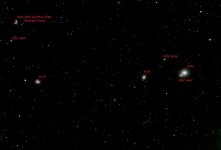
Information from:
https://www.nasa.gov/feature/goddard/2017/messier-60
https://apod.nasa.gov/apod/ap190201.html
https://www.nasa.gov/feature/goddard/2018/messier-58
Cheers
M 60, the third brightest member of the cluster, is an elliptical galaxy discovered by Johann Gottfried Keohler in April of 1779; Charles Messier added it to his catalogue 4 days later. M 60 is an elliptical galaxy, which unlike spiral galaxies, lack an organized structure and appear rather featureless. M 60 has a diameter of about 120,000 light years and has at its center a super massive black hole about 4.5 billion times as massive as the sun, one of the most massive black holes ever found. M 59, discovered by Gottfried Keohler at the same time as M 60, is also an elliptical galaxy. The central region of M 59 rotates in the opposite direction to the rest of the galaxy. M 58, discovered by Charles Messier in 1779, is a barred spiral galaxy, and one of the brightest in the Virgo Cluster. Located roughly 62 million light-years from Earth, M58 is the most distant Messier object.
NGC 4647 is a spiral galaxy that that neighbors M 61 and is about 2/3 the size of M 60, or about the size of our own Milky Way. It’s unclear if the 2 galaxies, which from our vantage point appear to overlap, actually interact; there is no evidence of new star formation, which is one of the clearest pieces of evidence for an interaction. Very recent detailed images from Hubble suggest the onset of some tidal interaction.
NGC 4567 and NGC 4568, called by some the Butterfly Galaxies and others the Siamese Twins, are a pair of spiral galaxies. The twins don’t seem to be too distorted by gravitational tides, but their molecular clouds are known to be colliding and are likely fueling giant star cluster formation.
Given the below is from just 7 light exposures (imaging was interrupted when IT decided it was time for an automated software update), it isn't too bad:

Information from:
https://www.nasa.gov/feature/goddard/2017/messier-60
https://apod.nasa.gov/apod/ap190201.html
https://www.nasa.gov/feature/goddard/2018/messier-58
Cheers

